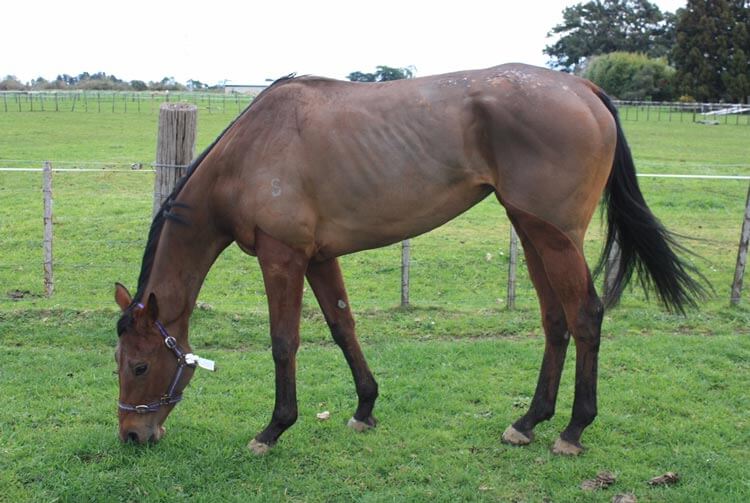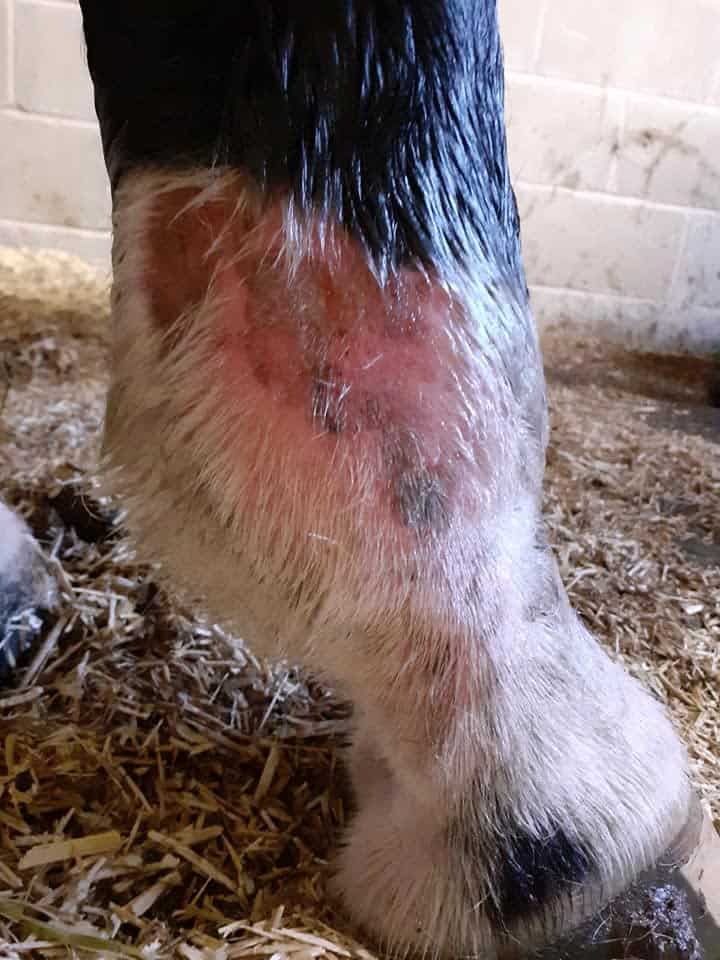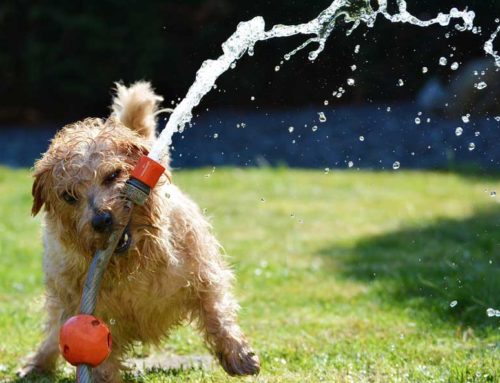How To Get Rid Of Rain Scald In Horses – Treatment And Prevention
Rain rot is a common skin condition of horses living in regions with high rainfall that often results in hair loss, lameness and loss of performance. Other common names for it include: greasy heel, mud fever, rain scald, or dermatophilosis.
This type of skin problem can be particularly difficult to treat and can be exacerbated by a variety of factors including hot humid weather, stress, immunocompromise, and poor nutrition.
And contrary to popular belief, rain rot in horses is not due to neglect or poor equine husbandry.
In this article, we describe why rain rot occurs so that you can prevent it in the first instance, and we provide you with treatment guidelines.
Read on to find out how you can help your horse.

What Causes Equine Rain Rot
Rain rot is the name given for a bacterial infection that affects the outermost layer of the horse’s skin caused by a bacterium known as Dermatophilus congolensis.
This skin disease seems to be more prevalent in animals with white limbs, although it can occur in horses with dark hair, particularly on their rump and flanks.
It’s not uncommon for other bacteria such as Staphlococcus spp, fungus such as Malassezia or Trichophyton and/or mites to also be present and complicate the infection.
However, it must be recognised that rain rot is a condition caused by bacteria and is NOT a primary fungal infection.
While D. congolensis is a commensal organism found on the skin of many animals (sheep, cattle, equine), it is usually dormant meaning that while it’s present, it doesn’t cause infections.
Infection can occur in any horse when there is a reduction in systemic or local skin resistance such is often the situation when there are wet conditions with high humidity.
These environmental conditions disrupt the natural permeability of the skin integument causing it to soften making it far more susceptible to wounds and penetration by bacteria and/or insect bites.
Skin that is continuously exposed to moisture is prone to rain rot infection
Not only that, wet weather, high humidity, and low oxygenation levels increase the replication rate of bacterial zoospores, resulting in the perfect storm.
Horses that have a compromised immune system from conditions such as Cushing’s disease, metabolic syndrome or a high parasite burden or malnutrition are more predisposed to rain rot.
It also needs to be noted that dermatophilus can be highly contagious amongst susceptible horses, with spores being spread by mechanical vectors such as insects, grooming materials, riding equipment, and covers.
Given optimal environmental conditions, spores can remain active in the ground for quite some time.
It should be noted that some horse skin conditions can resemble rain scald, but in actual fact are not caused by the bacteria. Instead, these conditions could be caused by photosensitisation or other immune diseases.
It is recommended that a skin biopsy is performed to confirm a diagnosis if common treatment strategies have not been effective. We will describe photosensitisation in another article.

What Are The Signs Of Rain Scald In Horses
Rain rot is often seen on the legs, rump, and neck, but it can also affect other parts of the body such as the girth, muzzle and skin around the eyes.
Affected areas are usually those that remain damp for long periods, either due to standing on wet ground, or having a long hair-coat that traps moisture either from sweat, rain or not drying appropriately before covering.
The most common clinical sign that should alert equine owners of a potential rain rot infection is when clumps of hair become raised rather than lying flat and there is a distinct lumpy feel to the skin.
As dermatitis develops the area will become dry and flaky with small papules of pus and extensive hair loss.
In particularly severe cases, especially on legs, crusty scabs will often form resulting in a region that is swollen with scabs, tufts of hair combined with hair loss and exudate oozing from open sores.
These horses are often extremely painful and can be difficult to handle.

Diagnosis
Given a history of high rain and humidity combined with a horse with clinical signs of dermatitis over the topline or on the legs particularly the pastern region a presumptive diagnosis of rain rot is not difficult to make.
However, it should always be noted that other bacterial or fungal skin disease could be active and involving your vet in the diagnosis could save you a lot of time and your horse a lot of pain and discomfort if you get it wrong.
A definitive diagnosis is most commonly made by cytologic examination of fresh, active crusts and/or impression smears of the moist part of a fresh scab. In some circumstances a skin biopsy from the edge of an untreated, active region is useful.
Hygiene Matters
Due to the contagious nature of greasy heel, strict hygiene is required to ensure that you don’t contaminate the environment and risk spreading this to others in the herd or stable.
- Always wear gloves when treating or handling affected ponies.
- Make sure all scabs and hair that is removed is collected and disposed of in a rubbish container (not compost or a dung pile) and burned. Leaving them on the ground will just contaminate that area.
- Make sure all equipment is either disposed of or thoroughly cleaned using bleach before using on other animals.
Treatment Of Rain Rot
When developing a treatment plan for a rain rot infected horse, horse owners need to remember the key reasons why it develops in the first instance:
- presence of moisture – usually due to rain
- presence of high humidity
- damage to the skin integument – usually due to persistent wetness
- low oxygenation
Our treatment options must minimise these conditions to be effective.
Minimise Moisture
The basic first step when treating a horse with rain rot is to minimise the presence of moisture.
This can be incredibly difficult if your horse lives outside in a heavy rainfall area and a paddock that is mud.
If your horse is continually suffering, it may mean that you need to organise a stable or undercover yard during these months of the year.
Mud Fever Can Be Incredibly Painful
Effective treatment of rain rot is based on opening the areas of infection to the air and decontamination.
For most infections clipping hairy areas, removing crusty scabs, and using medicated shampoos and topical treatments will be adequate.
In some situations, particularly when the rain rot occurs on the legs, this process can be incredibly painful and will require a veterinarian to assist with initial sedation and cleaning.
Treatment Steps
- Sedate if required
- Clip affected regions to remove excess hair and expose all lesions to an oxygen-rich environment
- Wash the affected area using a medicated antibacterial shampoo to soften scabs so that they can be removed.
- thoroughly lather the soap and leave on the area for 10-15minutes to facilitate softening.
- Remove scabs (these contain high numbers of bacterial zoospores and must be carefully disposed of).
- this step is essential, scabs contain high numbers of bacteria
- yellow-green pus is often found under scabs
- bleeding will likely occur – this is normal
- Repeat washing the area with soap and thoroughly rinse the area with fresh water to remove all soap residue.
- Thoroughly dry the area.
- Apply a penicillin-based antibacterial cream (vets will often supply dry-cow preparations for this purpose).
- avoid glycerine based products – these trap moisture
- avoid products containing steroids such as prednisone – these delay healing
- Allow the area to dry completely before replacing rugs or bandaging (if required).
- this is when a hairdryer comes in handy!
It is preferable to leave affected areas open to the air if possible and avoid bandaging.
However, if housed in a paddock and it’s impossible to keep the leg moisture-free, then a bandage will be required.
Make sure that the bandage is applied to a dry limb and that no creams or ointments under the bandage are still wet when the bandage is applied.
Never use plastic wrap as this will create heat and a humid environment perfect for spore replication.
Bandages will need to be replaced daily, especially in wet weather as a moist bandage will contribute to bacterial growth.
In severe cases, your vet will need to prescribe a nsaid for pain relief and some refractory cases may require systemic antibiotics.
If the infection is complicated by the presence of mites, an ivermectin/moxidectin based horse-wormer will kill these.
Types Of Medicated Shampoo
The most common medicated shampoos to treat rain rot contain either povidone iodine or chlorhexidine as active ingredients.
It’s important to note that medicated shampoos, regardless of formulation, can strip the outer layer of skin of it’s protective barrier oils.
We recommend using these products sparingly in horses with healthy skin – a shampoo once per week is more than enough.
For infected animals, it is best to spot treat only those areas with active infection.
How Long Does It Take To Cure
In mild cases of equine rain-rot, killing the bacteria is relatively quick when treated appropriately in a timely fashion, with resolution of active infection occurring within a week.
However, when environmental conditions are difficult to control and there are complicating factors such as immunocompromise from Cushing’s disease or just a huge area to treat, it can take quite some time to get on top of this condition.
How To Prevent Rain Rot
Prevention can be split into two key areas: horse factors and environmental management.
Management Of Horse factors
Minimising excessive dampness at the level of the skin surface is the key to preventing rain-scald in all animals.
Healthy skin provides a natural barrier against dermatophytes and understanding how conditions causing immunocompromise can affect this is paramount.
There is no denying that prevention can be extremely difficult when conditions are wet and muddy, but you can help by:
- clipping the coat short to facilitate speedy drying.
- ensure rugs are waterproof and have good airflow.
- don’t apply bandages or horse covers to a wet or sweaty horse.
- groom daily to keep clean and check for small wounds.
- Be careful not to overwash especially with harsh antimicrobial shampoo. These medicated shampoos strip natural oils from the skin layer. It’s recommended to only use these once a week.
- Try to keep infected horses quarantined (separated) from others on the farm.
- Perform regular faecal egg counts to determine egg burden and requirement for worming.
- Treat concomitant conditions such as Cushing’s and malnutrition.
- Use insect repellents if insect numbers are high and your horse is bothered.
Environmental Management
Again, the key is to avoid excessive moisture:
- avoid access to muddy areas by taping off affected areas.
- rotate paddocks frequently to avoid the development of muddy areas.
- place rocks/stones in gateways of mud-prone paddocks
- muck out and remove wet bedding from stables at least once per day
It’s also important to minimise flies and mosquitoes that can act as a vector for the spread of the bacteria.
- muck out paddocks and dispose of dung piles frequently
- fix areas that pool stagnant water, these can be a haven for mosquitos.
Make sure grooming equipment is kept clean and ideally each horse should have their own specific grooming kit and tack.
Sharing contaminated grooming tools and tack is a sure way to spread mud fever amongst a stable of horses.
If your horse is suffering from rain rot and you need vet advice, our team of vets are available 24/7.




Leave A Comment